Study on Acoustic–Electric Response Characteristics of Unsaturated Loess under Different Moisture Content
Abstract
1. Introduction
2. Test Scheme
2.1. Physical Properties of Soil Samples
2.2. Sample Preparation
2.3. Test Methods
2.3.1. Low-Field NMR Test
2.3.2. Wave Velocity Test
2.3.3. Resistivity Test
3. Results
3.1. T2 Spectrum Distribution of Soil Samples with Different Moisture Content
3.2. The Variation in Resistivity as a Function of Moisture Content
3.3. The Variation in Longitudinal Wave Velocity as a Function of Moisture Content
4. Analysis and Discussion
4.1. Theoretical Analysis of Relation between Moisture Content and Resistivity
| Moisture Content/% | 5 | 7.5 | 10 | 12.5 | 15 | 17.5 | 20 | 22.5 | 25 | 27.5 | 30 |
| Saturation | 0.18 | 0.27 | 0.36 | 0.45 | 0.54 | 0.63 | 0.72 | 0.81 | 0.91 | 0.99 | 1 |
4.2. Theoretical Analysis of Relation between Moisture Content and Wave Velocity
4.3. Analysis of Soil Wave Velocity Propagation Based on Modified Theoretical Model
4.4. The Relationship Model between Resistivity and Wave Velocity and Verification
5. Conclusions
- 1.
- With the increase in moisture content, the water-bearing porosity of loess samples increases, the small pores gradually expand into large pores, and the proportion of free water increases, which affects the resistivity and longitudinal wave propagation.
- 2.
- Under constant dry density conditions, with increasing moisture content, the resistivity gradually decreases until it stabilizes, indicating a power function type of relationship. The changes in wave velocity with respect to moisture content can be divided into two stages: rapid decline followed by rapid rise. The theoretical model of soil wave velocity is consistent with the trend of the rapid decline stage but not applicable to the rapid rise stage.
- 3.
- Based on the assumption regarding the distribution of pore water within the loess samples, we propose a refined relationship between wave velocity, moisture content, and saturation. The accuracy of this revised formula is validated through a comparison with measured data.
- 4.
- Taking moisture content and saturation as a bridge, the relationship expression between wave velocity and resistivity of loess is obtained, and the calculated results of this expression are basically consistent with the actual test data. It can provide a theoretical model for the mutual characterization of loess resistivity and wave velocity in practical engineering and the joint inversion of wave velocity and resistivity in integrated geophysical exploration. At present, the correctness of this model has only been verified in the laboratory, and the next focus of work is to further verify the applicability of this model in different engineering settings.
Author Contributions
Funding
Data Availability Statement
Acknowledgments
Conflicts of Interest
References
- Sun, P.; Zhang, M.; Jia, J.; Cheng, X.; Zhu, L.; Jiang, J.; Xun, Q. Geo-hazards research and invesgation in the loess regions of western China. Noethwest. Geogoly 2022, 55, 96–107. [Google Scholar]
- Tang, X.; Zhang, W.; Dong, C.; Tang, F.; Liu, C. Evolution of cumulative plastic strain in loess under freeze-thaw cycles. China Earthq. Eng. J. 2024, 46, 136–145. [Google Scholar]
- Yang, Z.; Zhang, J.; Zhang, S.; Yan, C. Research progress on foundation treatment techniques of expressway in Loess Area. J. Chang. Univ. (Nat. Sci. Ed.) 2022, 42, 16–32. [Google Scholar]
- Hong, Q.; Lai, H.; Liu, Y. Failure analysis and treatments of collapse accidents in loess tunnels. Eng. Fail. Anal. 2023, 145, 107037. [Google Scholar] [CrossRef]
- Xue, J.; Wei, Z.; Zhang, W.; Zhao, X.; Zhang, F.; Liu, X. Study on the seismic reinforcement of damaged underground loess cave dwellings by shaking table test. Eng. Mechanics. 2024, 1–14. [Google Scholar]
- Zhang, S.; Chen, X. Ecological design of loess building materials. Shanxi Archit. 2021, 47, 18–20. [Google Scholar]
- Feng, L.; Zhang, M.; Jin, Z.; Zhang, S.; Sun, P.; Gu, T.; Liu, X.; Lin, H.; An, Z.; Peng, J.; et al. The genesis, development, and evolution of original vertical joints in loess. Earth Sci. Rev. 2021, 214, 103526. [Google Scholar] [CrossRef]
- Zhang, M.; Sun, P.; Cheng, X.; Zhu, L.; Xun, Q. Geo-Hazards Research Report in the Loess Region of Northwest China; Xi’an Geological Survey Center, China Geological Survey: Xi’an, China, 2015. [Google Scholar]
- Manli, S.; Fei, F.; Yunxia, S. Review on soil moisture content measurement methods. J. Northwest Univ. (Nat. Sci. Ed.) 2019, 49, 219–229. [Google Scholar]
- Meju, M.A.; Gallardo, L.A.; Mohamed, A.K. Evidence for correlation of electrical resistivity and seismic velocity in heterogeneous near-surface materials. Geophys. Res. Lett. 2003, 30. [Google Scholar] [CrossRef]
- Archie, G.E. The electrical resistivity log as an aid in determining some reservoir characteristics. Trans. AIME 1942, 146, 54–62. [Google Scholar] [CrossRef]
- Keller, G.V.; Frischknecht, F.C. Electrical Methods in Geophysical Prospecting; Pergamon Press: New York, NY, USA, 1966. [Google Scholar]
- Waxman, M.H.; Smits, L.J.M. Electrical conductivities in oilbearing shaly sands. Soc. Pet. Eng. J. 1968, 8, 107–122. [Google Scholar] [CrossRef]
- Rhoades, J.D.; Raats, P.A.C.; Prather, R.J. Effects of liquid-phase electrical conductivity, moisture content, and surface conductivity on bulk soil electrical conductivity. Soil Sci. Soc. Am. J. 1976, 40, 651–655. [Google Scholar] [CrossRef]
- Rinaldiv, A.; Cuestasg, A. Ohmic conductivity of a compacted silty clay. J. Geotech. Geoenvironmental Eng. 2002, 128, 824–835. [Google Scholar] [CrossRef]
- Zhou, M.; Wang, J.; Fan, X.; Huang, S.; Dou, P.; Wang, Y. Temperature Correction Models for Soil Electrical Resistivity in Pearl River Delta. High Volt. Eng. 2012, 38, 623–631. [Google Scholar]
- Hadzick, Z.Z.; Guber, A.K.; Pachepsky, Y.A.; Hill, R.L. Pedotransfer functions in soil electricalresistivity estimation. Geoderma 2011, 164, 195–202. [Google Scholar] [CrossRef]
- Zhang, L.; Pan, B.; Li, Z.; Mo, X.; Xia, Z.; Xu, W. New three-water conduction model and its application in evaluation of low porosity and low permeability reservoir. Oil Geophys. Prospect. 2010, 44, 4011. [Google Scholar]
- Zhu, C.H.; Li, N. Mesoscopic deformation mechanism of loess high-fill foundation based on soil electrical resistivity. Chin. J. Rock Mech. Eng. 2013, 32, 640–648. [Google Scholar]
- Sun, B.; Gu, T.; Kong, J.; Zhang, F.; Sun, J. Experimental Research on Relationship between Resistivity and Moisture Content of Unsaturated Loess. Northwest. Geol. 2020, 53, 216–222. [Google Scholar]
- Kassab, M.A.; Weller, A. Porosity estimation from compressional wave velocity: A study based on Egyptian sandstone formations. J. Pet. Sci. Eng. 2011, 78, 310–315. [Google Scholar] [CrossRef]
- Donohue, S.; Forristal, D.; Donohue, L.A. Detection of soil compaction using seismic surface waves. Soil Tillage Res. 2013, 128, 54–60. [Google Scholar] [CrossRef]
- Wei, B.; Gong, S.; Liu, B.; Liu, X.; Ouyang, Y. Changes of Expansive Soil’s Meso-structure and Its Relation with Acoustic Velocity. J. Yangtze River Sci. Res. Inst. 2016, 33, 93–97. [Google Scholar]
- Huang, X.; Li, D.; Ming, F.; Zhang, Y.; Bing, H. Experimental study on acoustic wave propagation properties of frozen remolded loess during uniaxial loading process. Chin. J. Geotech. Eng. 2015, 37, 1660–1667. [Google Scholar]
- Irfan, M.; Uchimura, T.; Chen, Y. Effects of soil deformation and saturation on elastic wave velocities in relation to prediction of rain-induced landslides. Eng. Geol. 2017, 230, 84–94. [Google Scholar] [CrossRef]
- Chen, Y.; Uchimura, T. Model tests of evaluation behaviors of the elastic wave velocity during the failure process of soil slopes due to rainfall. Chin. J. Rock Mech. Eng. 2019, 38, 2138–2150. [Google Scholar]
- Wu, Y.; Lan, H.; Huang, W. Relationship between wave velocities and moisture content of unsaturated loess. Chin. J. Geophys. 2021, 64, 3766–3773. [Google Scholar]
- GB/T 50123-2019; Standard for Geotechnical Test Methods. Ministry of Housing and Urban-Rural Development: Beijing, China, 2019.
- Tian, H.; Wei, C. A NMR-based testing and analysis of adsorbed moisture content. Sci. Sin. 2014, 44, 295–305. [Google Scholar]
- Kong, C.; Wang, M.; Shi, X.; Xu, S.; Guo, N.; Yang, P. Study on Water Holding Capacity and Pore Characteristics of Soils Based on LF-NMR. Acta Pedol. Sin. 2016, 53, 1130–1137. [Google Scholar]
- Qin, S. Determination of the resistivity of tap water. Phys. Bull. 2012, 78–79. [Google Scholar]
- Shi, G.; Shen, W.; Yang, D. The relationship of wave velocities with saturation and fluid distribution in pore space. Chin. J. Geophys. 2003, 46, 138–142. [Google Scholar]
- Deng, H.; Yuan, X.; Li, J.; He, M.; Luo, Q.; Zhu, M. Experimental research on influence of saturation degree on sandstone longitudinal wave velocity and strength. Chin. J. Rock Mech. Eng. 2013, 32, 1625–1631. [Google Scholar]
- Yang, W.; Song, J.; Liu, B.; Li, S.; Xu, X.; Liu, Z.; Niu, L. Experimental research on wave velocity and electrical resistivity of rock-like material during saturation process. Chin. J. Rock Mech. Eng. 2015, 34, 703–712. [Google Scholar]
- Brutsaert, W. The propagation of elastic waves in unconsolidated granular mediums. J. Geophys. Res. 1964, 243–257. [Google Scholar] [CrossRef]
- Adamo, F.; Attivissimo, F.; Fabbiano, L.; Giaquinto, N.; Spadavecchia, M. Soil moisture assessment by means of compressional and shear wave velocities: Theoretical analysis and experimental setup. Measurement 2010, 43, 344–352. [Google Scholar] [CrossRef]
- van Genuchten, M.T. A closed-form equation for predicting the hydraulic conductivity of unsaturated soils. Soli Sci. Soc. Am. J. 1980, 44, 892–898. [Google Scholar] [CrossRef]
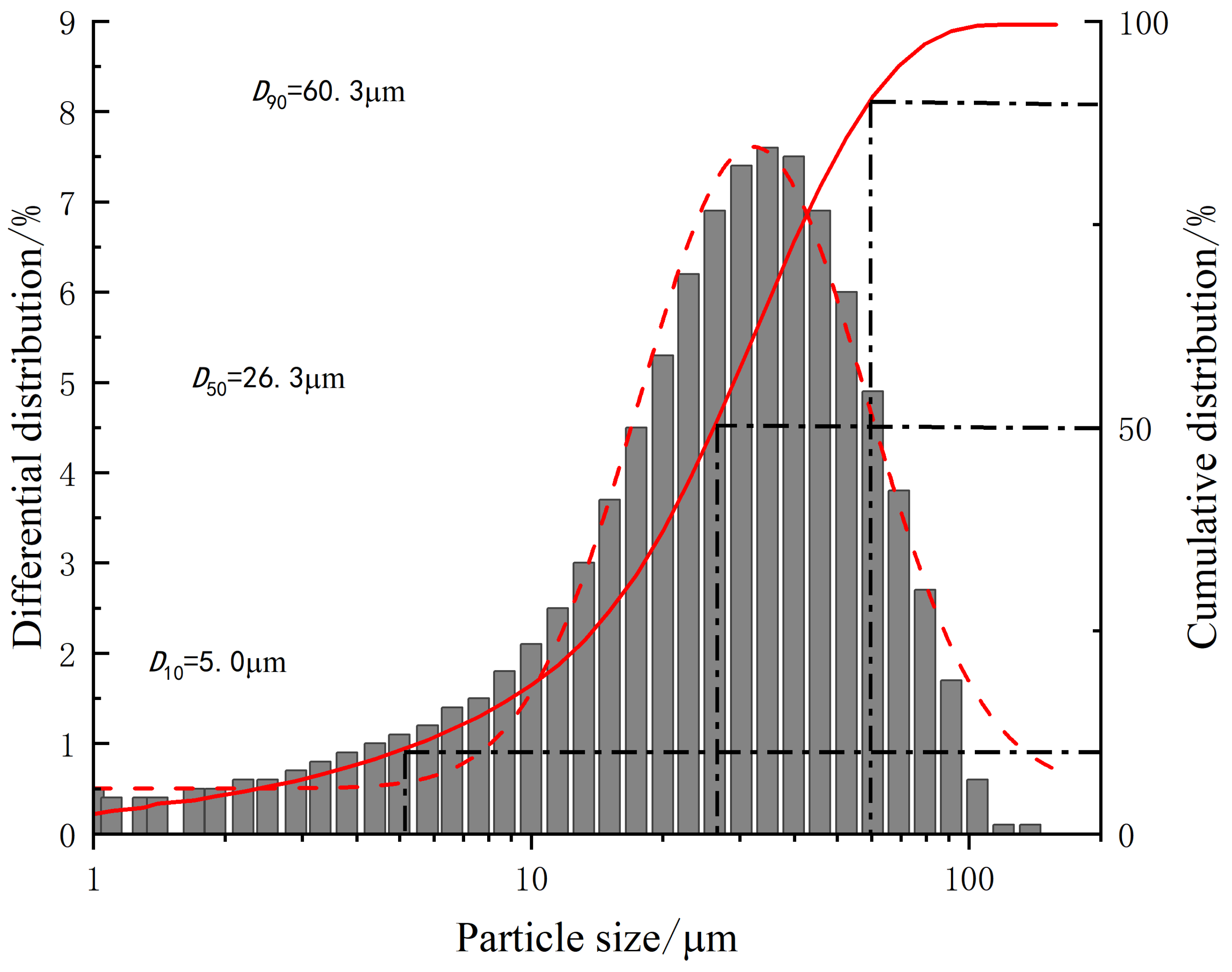


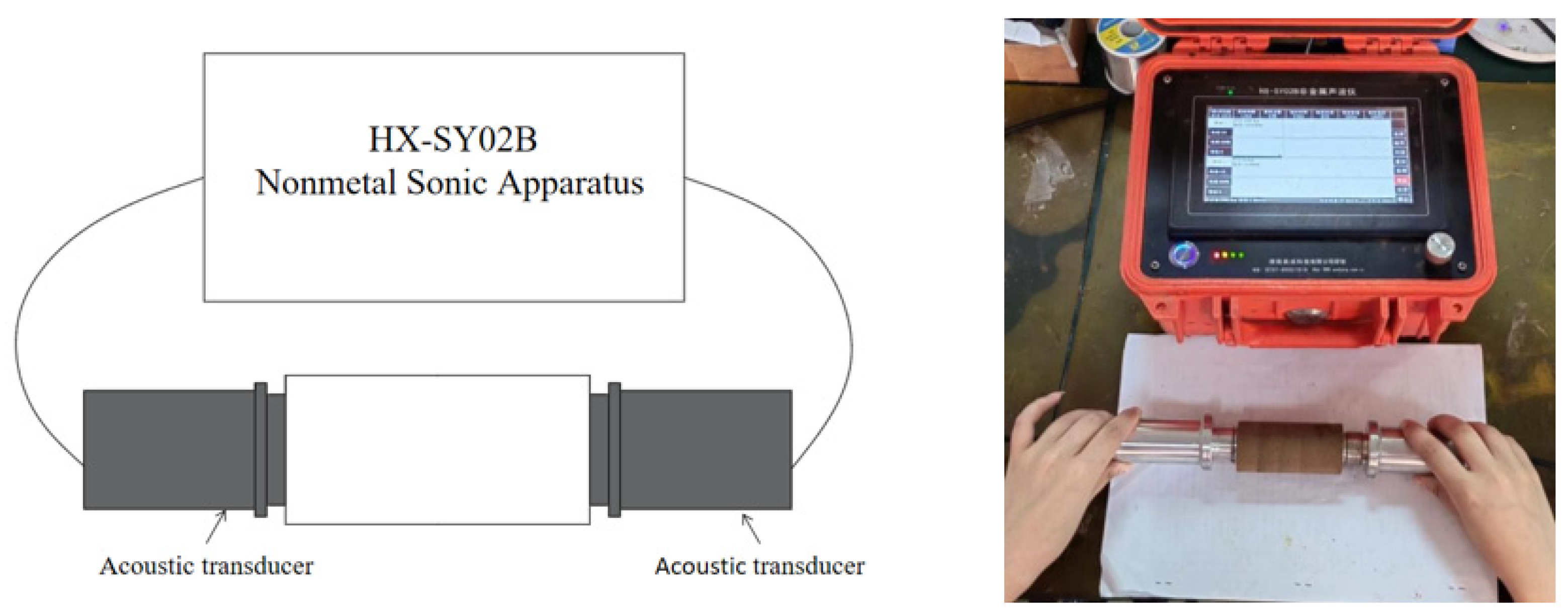
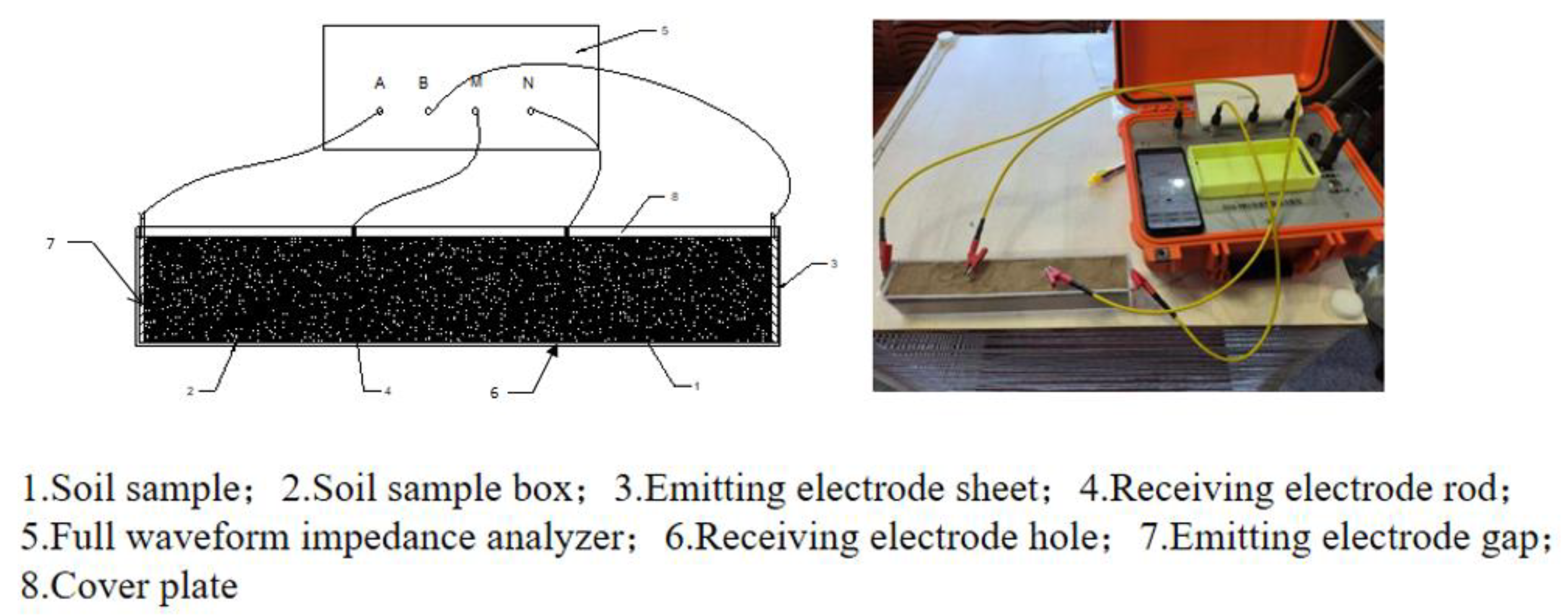




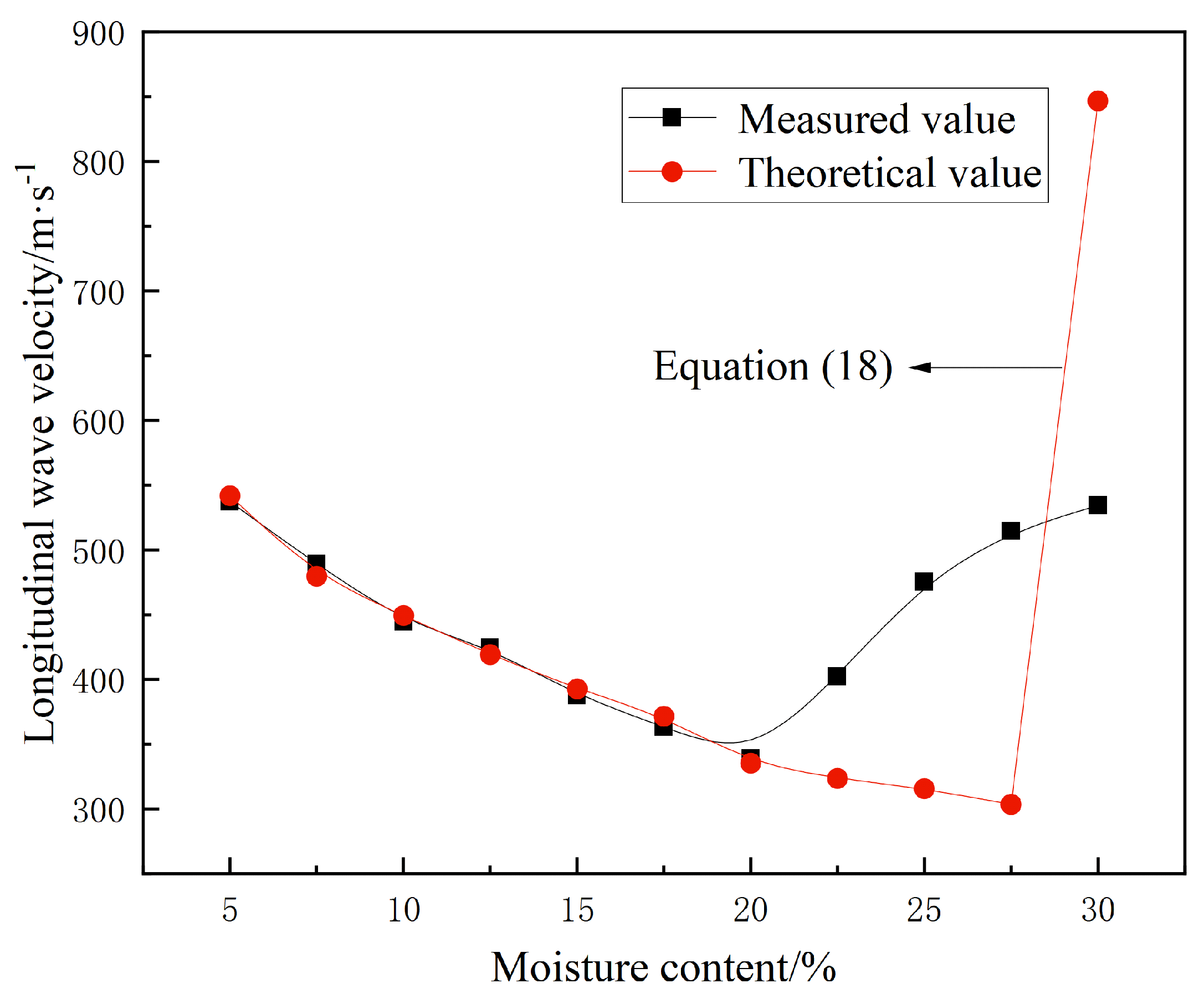
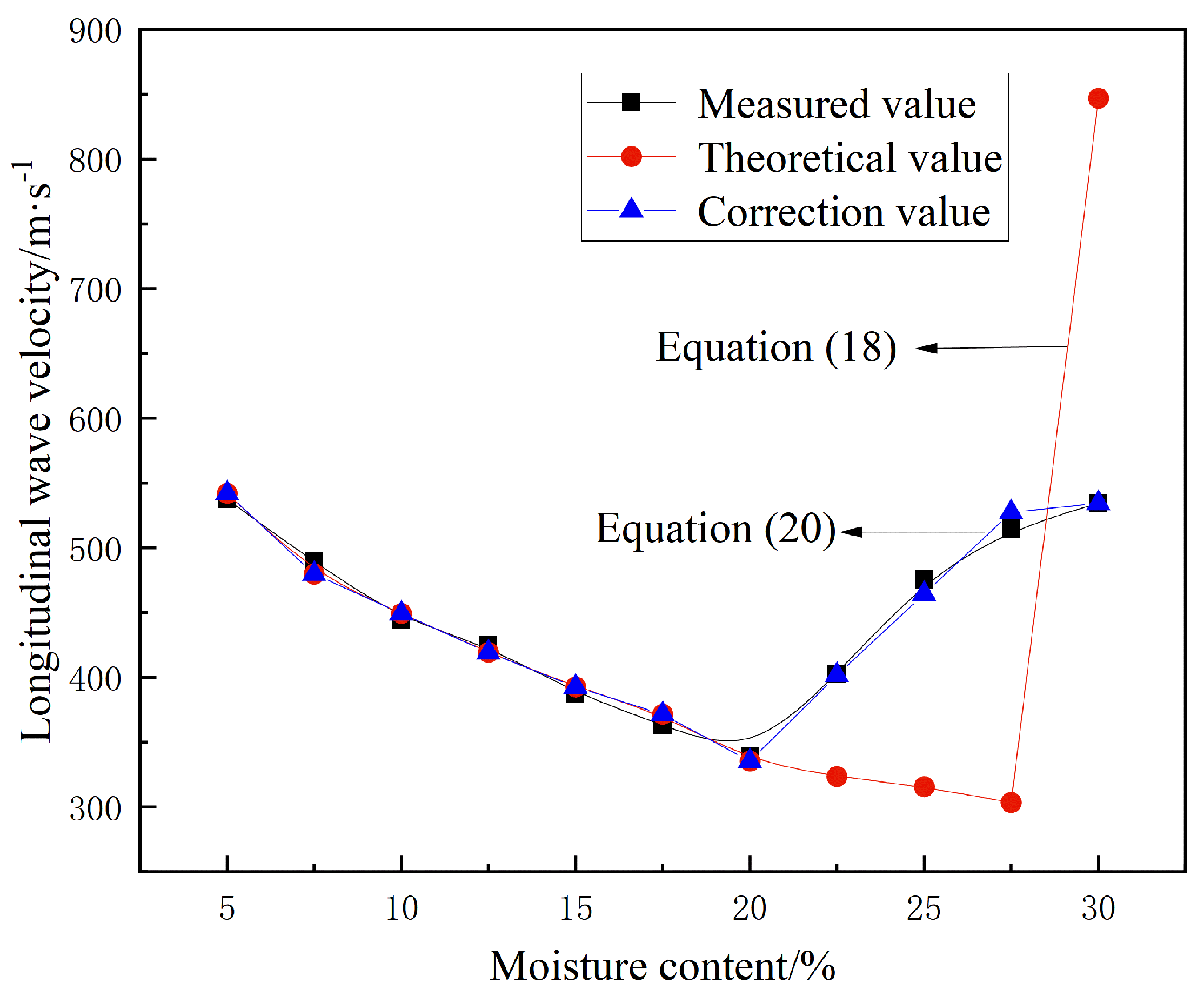
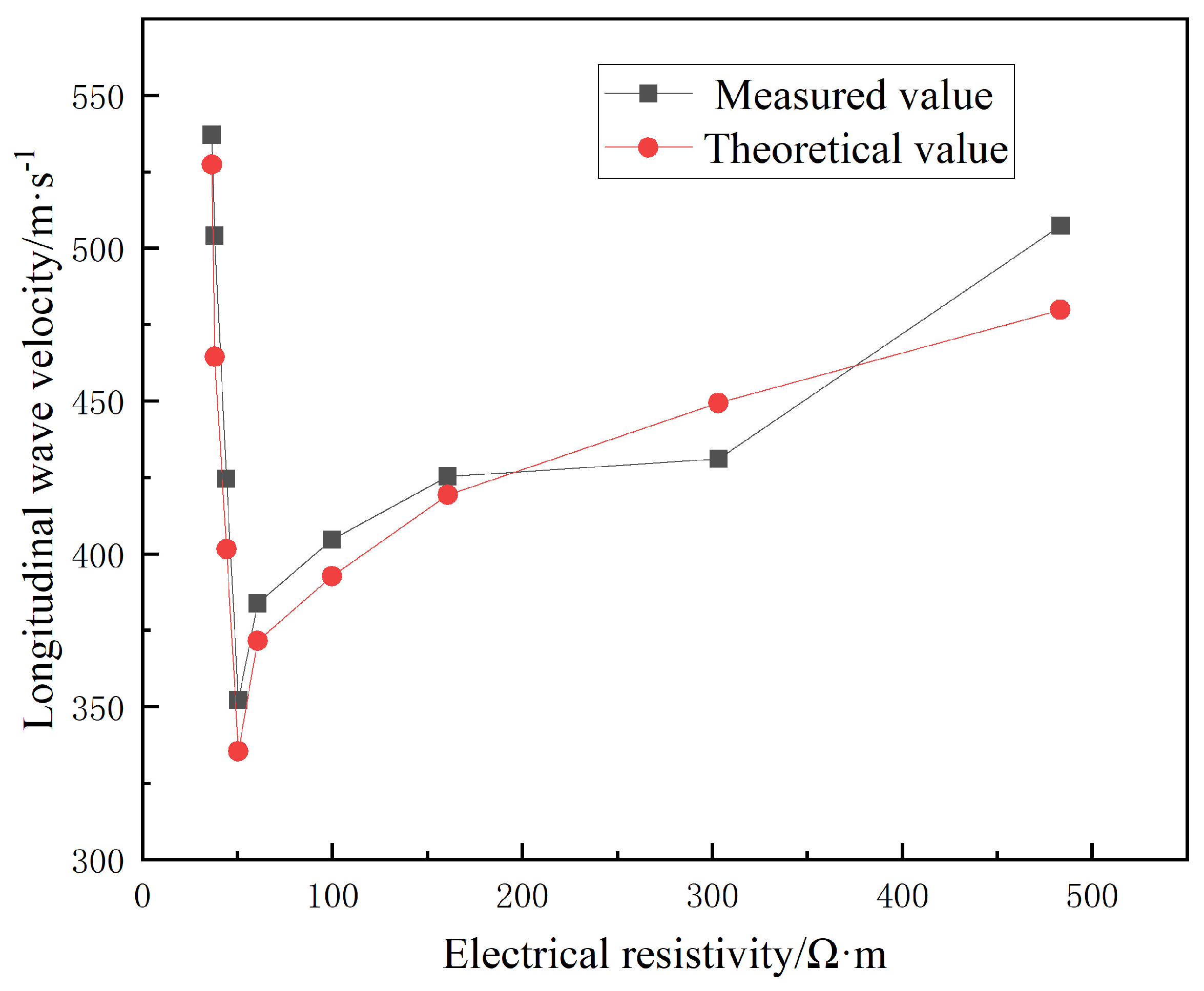
| Liquid Limit/% | Plastic Limit/% | Plasticity Index | Optimal Moisture Content/% | Maximum Dry Density (g/cm3) | Grain Composition mm/% | ||
|---|---|---|---|---|---|---|---|
| >0.075 | 0.005~0.075 | <0.005 | |||||
| 27.17 | 14.16 | 13.02 | 13.70 | 1.80 | 81.7 | 15.9 | 2.4 |
Disclaimer/Publisher’s Note: The statements, opinions and data contained in all publications are solely those of the individual author(s) and contributor(s) and not of MDPI and/or the editor(s). MDPI and/or the editor(s) disclaim responsibility for any injury to people or property resulting from any ideas, methods, instructions or products referred to in the content. |
© 2024 by the authors. Licensee MDPI, Basel, Switzerland. This article is an open access article distributed under the terms and conditions of the Creative Commons Attribution (CC BY) license (https://creativecommons.org/licenses/by/4.0/).
Share and Cite
Li, J.; Zhang, T.; Zhou, Z.; Li, D.; Teng, J. Study on Acoustic–Electric Response Characteristics of Unsaturated Loess under Different Moisture Content. Buildings 2024, 14, 819. https://doi.org/10.3390/buildings14030819
Li J, Zhang T, Zhou Z, Li D, Teng J. Study on Acoustic–Electric Response Characteristics of Unsaturated Loess under Different Moisture Content. Buildings. 2024; 14(3):819. https://doi.org/10.3390/buildings14030819
Chicago/Turabian StyleLi, Jielin, Tong Zhang, Zhiwei Zhou, Daqian Li, and Jidong Teng. 2024. "Study on Acoustic–Electric Response Characteristics of Unsaturated Loess under Different Moisture Content" Buildings 14, no. 3: 819. https://doi.org/10.3390/buildings14030819
APA StyleLi, J., Zhang, T., Zhou, Z., Li, D., & Teng, J. (2024). Study on Acoustic–Electric Response Characteristics of Unsaturated Loess under Different Moisture Content. Buildings, 14(3), 819. https://doi.org/10.3390/buildings14030819






